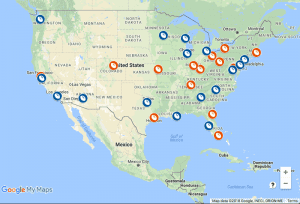To promote minority languages, the government created the Centre`s Community Relations Unit to develop a guideline on the use of languages for Irish, Ulster and the languages of other communities. In December 1999, the North/South Languages Implementation Body entered into force to uphold the government`s commitment to support linguistic diversity under the agreement.1 “The Good Friday Agreement: Culture”,” BBC News, accessed February 7, 2013, www.bbc.co.uk/northernireland/schools/agreement/culture/irish2.sh. Negotiations were lengthy and largely deadlocked at the end of 1997. This was followed by a series of sectarian murders that threatened to derail the trial.70 In January 1998, the British and Irish governments presented a short document negotiated with Trimble.71 In March 1998, Mitchell announced an April 9 deadline to conclude the talks. The choice of date was not entirely arbitrary, as the legislation establishing the Forum was due to expire in May 1998.72 In addition, Mitchell believed that the agreement should be concluded and a ratification referendum was being held before the “march season” in July, a period of high tension in Northern Ireland.73 The parties agreed on Good Friday: On April 10, 1998, after parallel interventions by Blair (in the form of a written letter) and Clinton (in the form of a phone call with Trimble) to assure the Unionists that the agreement would not be implemented if the IRA did not go ahead with the dismantling. In total, the formal talks lasted 21 months. 1. Participants recognize that policing is a central issue in any society. They also recognise that the history of deep divisions in Northern Ireland has made it very moving, with major injuries and sacrifices suffered by many individuals and their families, including those of the RUC and other civil servants. They believe the agreement offers the possibility of a fresh start for policing in Northern Ireland with a police service capable of receiving and maintaining support from the community as a whole. They also believe that this agreement offers a unique opportunity to create a new political dispensation that recognises the full and equal legitimacy and value of the identities, loyalty and ethics of all parts of the community in Northern Ireland.
They consider that this possibility should influence and support the development of a representative of the police service as regards the composition of the Community as a whole, which should be systematically disarmed in a peaceful environment. Under the agreement, it was proposed to build on the existing British-Irish interparliamentary body. Prior to the agreement, the body consisted solely of parliamentarians from the British and Irish parliaments. In 2001, as proposed in the agreement, it was extended to parliamentarians from all members of the British-Irish Council. A related feature of the process that was crucial was the sequence – the willingness to move the process forward without a firm commitment to a permanent ceasefire and at least the first steps towards the dismantling of paramilitary groups. The decision to move from preconditions to “subsequent conditions” was another feature that distinguished these negotiations from the Sunningdale Agreement and lifted the impasse that marred the process for most important years. The decision seems to be confirmed not only by the successful conclusion of the negotiations, but also by the subsequent closure of the IRA and the relatively low outpouring of disgruntled members of the paramilitaries. It is not difficult to imagine that an agreement reached by the SDLP and the UUP alone could have met with serious opposition from the IRA and loyalists, although, of course, the decrease in the effectiveness of the violence, which was evident in the late 1980s, could have mitigated the scale and duration of the reaction. On the 11th. In January 2020, as part of the new decade, the agreement on the new approach, the executive and the assembly of shared power were reinstated, with the participation of the five main political parties in Northern Ireland. The idea of the agreement was to get the two sides to work together in a group called the Northern Ireland Assembly.
The Assembly would take certain decisions previously taken by the British Government in London. Steps will be taken to monitor this issue and consider any measures that may be necessary. After the peace deal, the Loyalist Volunteer Force – a Protestant paramilitary group in Northern Ireland – announced a “clear” ceasefire ahead of the referendum and campaigned for a No. 2 after the referendum, which took place on September 22. In May 1998, the extremist republican group called the Real Irish Republican Army (RIRA), a splinter faction of the IRA, detonated a bomb in the town of Omagh, 55 miles west of Belfast, on August 15, 1998. The attack killed 28 people and injured more than 200.3 Immediately after the attack, RIRA apologized and called for a ceasefire.4 As leaders of our respective parties, we told each other that we consider the task of reaching agreement on a peaceful and democratic agreement for all on this island to be our greatest challenge. The agreement contained a complex set of provisions relating to a number of areas, including: at the same time, the inclusion of such different perspectives had two effects on the content of the agreement. First, the mutual suspicion of the parties led them to a pattern of concordance that blocked vetoes. This reduced the risk of one of the parties being put in a minority, making the deal more acceptable for their respective constituencies.102 However, this came at the expense of a possible paralysis.
On its own, an agreement involving only the UUP and the SDLP could have tipped the scales towards a more flexible approach. Secondly, deep divisions, even within the two sides, have led the parties to postpone important decisions on important substantive issues ranging from the future of the police to the role of North-South bodies, thus creating the conditions for the foreseeable crises that followed. Under these circumstances, power-sharing proved impossible. Meanwhile, voters in all communities began to turn away from moderate parties, and instead, support for Sinn Féin and the DUP increased, displacing the SDLP and UUP. For a significant part of the decade following the Good Friday Agreement, decentralization was suspended because the largest parties in each community were unable to reach an agreement on power-sharing. Progress has been made on dismantling, the implementation of which was confirmed in September 2005, but a political agreement has remained elusive. Finally, the British and Irish governments held important talks in St Andrews in October 2006. There, Sinn Féin finally agreed to accept the PSNI, while the DUP agreed to share power with Sinn Féin.
In May 2007, an Executive Director of the DUP, Sinn Féin, UUP and SDLP was finally able to take office. This time, the institutions created under the Good Friday Agreement were to remain in place until the current political crisis led to the collapse of the executive in January 2017. 102 Whether the agreement is really a concordance agreement is the subject of much debate among political scientists, see White, `Lessons from the Northern Ireland Peace Process: An Introduction`, 4; and the articles cited in footnote 2. But this procedural decision comes at a price. Since the process has contributed to the conclusion of a concordance agreement that protects the rights of both communities, but postpones the fight against many of the underlying sources of conflict (e.g. B, the police, economic equality, etc.), peace remains fragile, sectarian tensions remain high, and the institutions created by the agreement are hardly functional at best.113 These concerns have been taken into account by many participants in the agreement. Civil society during negotiations. But their voices have been marginalized in favor of the priority associated with getting men with arms to lay down their arms. .


